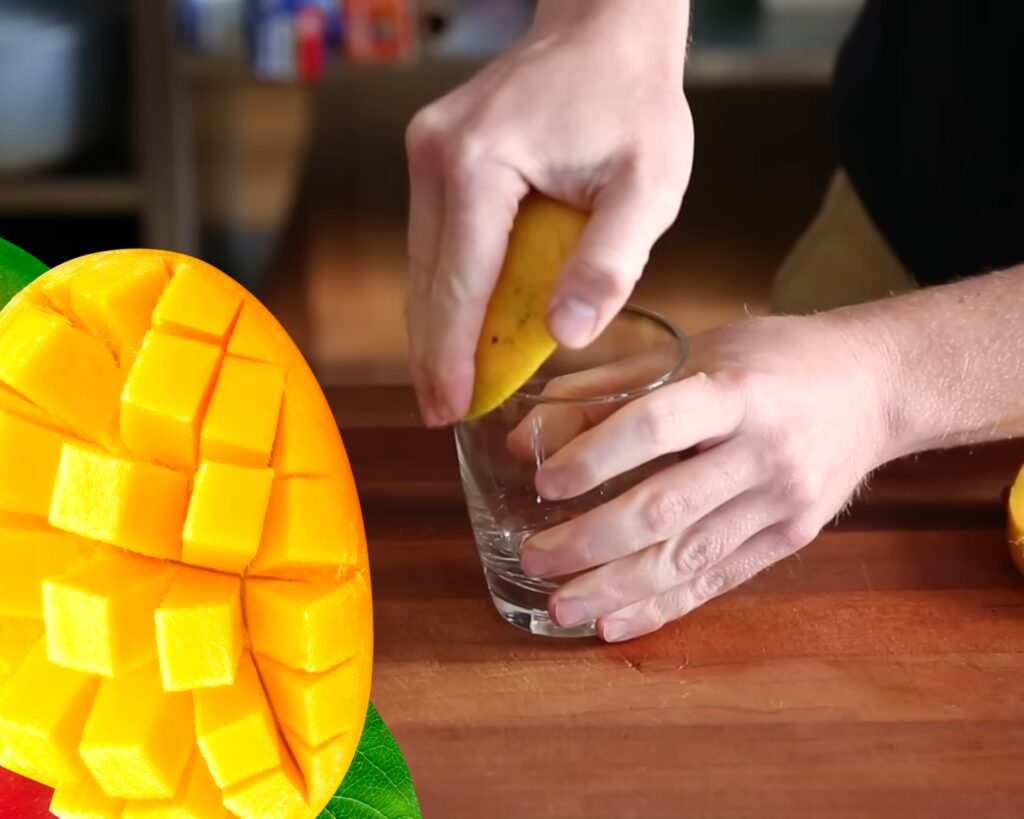You can peel a mango without a knife by using a glass with a thin rim to separate the flesh from the skin. Slide the edge of the mango down the rim of the glass, applying gentle pressure.
Peeling a mango can seem like a challenging task, especially when you’re without a knife or prefer a less sharp approach. The mango, with its delectable sweet flesh, is a favorite fruit for many but often comes with the dilemma of how to access its juicy goodness neatly. In this article, I will provide amazing tricks on how to peel a mango without a knife.
The glass method is a clever and safe technique to enjoy this tropical delight while keeping your fingers free from cuts. This simple trick not only minimizes waste but also provides a quick and mess-free solution, ideal for those who need to prepare a mango without traditional cutlery or are on the go. Mastering this method will ensure that you can savor every bit of your mango without any fuss.

Traditional Vs. Knifeless Mango Peeling
Welcome to the delicious world of mangos—a fruit so luscious and versatile, it can be enjoyed in countless ways. Today, let’s compare Traditional vs. Knifeless Mango Peeling. For many, handling a knife seems like the most straightforward approach, but the art of knifeless peeling has its charm and benefits. Let’s explore both techniques and find why mastering knife-free methods could be a sweet addition to your fruit preparation skills.
Pros And Cons Of Peeling Mangos With A Knife
Utilizing a knife for mango peeling is a common technique that many fruit connoisseurs default to. However, this method is like a double-edged sword with its own set of advantages and disadvantages.
- Pros:
- Precision in cutting
- Quick removal of skin
- Neater presentation of fruit slices
- Cons:
- Potential for injury
- Wastage of juicy fruit flesh if not done properly
- Requires skill and practice
Why Learn Knife-Free Methods?
Indulging in the sweetness of a mango doesn’t have to come with the risk of nicks and cuts. Knife-free methods offer a safe alternative and are particularly great when tools are scarce or when you wish to involve children in the kitchen. Furthermore, they are a lifesaver in situations such as picnics or outdoor gatherings where carrying knives may not be possible or safe.
Let’s explore a few reasons why learning these techniques is worth your while:
- Increased safety with no sharp tools involved
- Ideal for on-the-go snacking or travel
- It adds a fun, hands-on aspect to fruit preparation
- Environmentally friendly—no need for utensils
- It can be a gentler way to handle overripe mangos
Best Methods Of How To Peel A Mango Without A Knife
Mangoes are not only a sweet, juicy treat but also a bit of a challenge to peel, especially when you don’t have a knife on hand. But fear not mango aficionados! There are some easy and efficient ways to undress this tropical fruit without the need for sharp utensils. Embrace the mess-free joy of peeling mangoes with these creative, knife-free methods that will get you to that golden flesh in no time.

Using A Glass To Peel A Mango
One of the most efficient methods to peel a mango without a knife is to use a glass. This technique is as simple as it is ingenious, and it goes as follows:
- Cut off the sides of the mango, avoiding the hard pit in the center.
- Hold a piece of the mango with the skin facing out and the flesh facing down over a glass.
- Apply gentle pressure and slide the mango down the rim of the glass, allowing the glass to separate the flesh from the skin.
Not only is this approach quick, but it also minimizes waste, giving you the most fruit to enjoy.
Peeling With A Spoon As An Alternative
If a glass isn’t within reach, a spoon can be your next best friend for peeling a mango. Here’s how to make short work of the peeling process with a simple spoon:
- Slice the mango down either side of the central pit to create two halves.
- Use the edge of the spoon to find the division between the mango’s flesh and skin.
- Glide the spoon along this division, separating the flesh in one smooth motion.
With a little practice, you’ll scoop out beautifully clean mango halves, ready for slicing or dicing.
The Scoring And Peeling Technique
When neither glass nor a spoon is handy, turn to the scoring and peeling technique:
- Start by carefully scoring the mango with your fingernail or a plastic utensil, making long vertical and horizontal lines to create a grid pattern.
- Push from the underside of the mango until it turns inside out, making the cubes pop up.
- Nibble off the cubes directly or use your fingers or a spoon to gently remove them from the skin.
This method is particularly fun and easy for kids and adults alike, turning mango peeling into a playful activity.
Choosing The Right Mango For Knifeless Peeling
Beginner or expert, peeling a mango can seem intimidating without a knife. But let’s demystify this process! The secret lies not just in the technique, but primarily in the selection of the fruit itself. To effortlessly peel a mango without a knife, choosing the right mango is paramount. Understanding the level of ripeness and identifying the best candidates will ensure a hassle-free experience.
The Significance Of Mango Ripeness
Ripeness is not merely a detail; it’s the crux of knifeless mango peeling. An ideal mango oozes with juiciness and a soft texture that succumbs easily to alternate peeling methods. It’s about finding that sweet spot: not too firm and not overly ripe, where the flesh might be too mushy. Balancing in this ripeness middle ground is key to a clean peel and preserving the delectable flesh within.
Identifying And Selecting The Best Mangoes For No-cut Peeling
The art of selection can make or break your no-cut mango adventure. Here’s what you need to zero in on:
- Color: While color can be a helpful indicator, it’s not always foolproof due to varietal differences. A deeper hue generally signifies readiness, but always combine color with other cues.
- Texture: Gentle pressure should reveal a slight give, suggesting the perfect balance for knifeless peeling.
- Aroma: A sweet, fruity scent at the stem whispers of ripeness, inviting you to enjoy the flesh within.
Remember, the aim is to find a mango that respects the delicate dance of peeling without tools: one that won’t challenge your patience or compromise on flavor.
| Aspect | Description | No-Cut Peeling Suitability |
|---|---|---|
| Color | Deepening color, specific to variety | Good indicator when combined with other factors |
| Texture | Slight give under gentle pressure | Ideal for no-knife peeling |
| Aroma | Sweet fragrance at the stem | Signifies readiness for peeling |
With these qualities in mind, choosing the right mango becomes less of a guessing game and more of a strategic selection. Fruit that passes these checks ensures a peeling process as smooth as the mango’s flesh itself.
Tips For Perfecting Your Knife-free Peel
Welcome to the ultimate guide on how to peel a mango without using a knife. Mangos are delicious, but their slippery texture can make them a challenge to peel. Fear not, as mastering this technique ensures a mess-free and safe experience while preserving the luscious fruit inside. Let’s dive into tips for perfecting your knife-free peel.
Avoiding Mango Waste With Proper Peeling Methods
We all want to get the most out of our mangos, which means minimizing waste.
- Choose ripe mangos: A ripe mango is easier to peel and you’re less likely to waste any of the soft fruit.
- Glass method: Use a glass to separate the skin from the fruit. Cut the mango into halves, avoiding the pit, then slide the edge of the mango half along the rim of a sturdy glass. The flesh scoops into the glass and the skin remains outside.
- Scoring method: Use a blunt edge, such as the back of a spoon, to score the mango into cubes without breaking the skin. Then invert the scored half to push out the cubes and scoop them out.
Utilizing these techniques helps in obtaining every bit of the succulent mango while making sure nothing goes to waste.
How To Handle And Store Peeled Mangos
Maintaining the freshness of peeled mangos is crucial. Here are some tips:
- Airtight container: Place your peeled mangos in an airtight container to retain freshness. This prevents oxidation, which can alter taste and texture.
- Refrigeration: Refrigerate the peeled mango if not consumed immediately. The cool temperature slows down the process which causes the fruit to become overly soft and mushy.
- Freezing: For long-term storage, freeze the peeled mango. Lay pieces on a baking sheet lined with parchment, freeze until solid, then transfer to a freezer-safe bag or container.
Proper handling and storage ensure that the mangoes stay as delightful as when you first peeled them.

Creative Uses For Your Perfectly Peeled Mango
Successfully peeling a mango without a knife can feel like a culinary victory. With your mango flesh intact and ready for use, you might wonder, “What delicious creations can I concoct with this vibrant, juicy fruit?” Fear not—whether you’re seeking to enhance your meals or sweeten your desserts, peeled mangoes offer a treasure trove of possibilities that can invigorate your taste buds and add a healthy twist to your diet.
Simple And Healthy Mango Recipes
Fresh mangoes are powerhouses of vitamins, fiber, and antioxidants. Once you’ve mastered the art of peeling mangoes without a knife, transforming them into nutritious concoctions becomes both fun and effortless. Here are some mouth-watering recipes that are as simple as they are healthy:
- Mango Smoothie: Blend peeled mango chunks with low-fat yogurt, a drizzle of honey, and a splash of milk for a smooth, creamy delight.
- Mango Salsa: Combine diced mango with chopped cilantro, red onions, jalapeño, and a squeeze of lime juice for a zesty treat that pairs perfectly with grilled fish or chicken.
- Mango Salad: Toss sliced mango with mixed greens, toasted nuts, and a vinaigrette dressing for a refreshing and filling meal.
Incorporating Mangoes Into Meals And Desserts
Introducing mangoes to your daily meals and desserts not only brings a burst of tropical flavor but also enriches your diet with healthy nutrients. Here’s how you can infuse these luscious fruits into various dishes:
| Meal Type | Ideas |
|---|---|
| Breakfast | Mango topped oatmeal, Mango pancakes, or Mango-stuffed French toast |
| Lunch | Mango chicken wraps, Mango quinoa salad, or Mango curry |
| Desserts | Mango sorbet, Mango cheesecake, or Mango rice pudding |
Not only does the addition of mango offer a delightful twist to familiar recipes, but its natural sweetness can reduce the need for added sugars, making your dishes healthier. Embrace the versatility of mangoes and let this tropical fruit transform the way you experience food!
Final Thoughts And Common Pitfalls To Avoid
Peeling a mango does not have to be a struggle or require sharp tools. With the right techniques, you can enjoy this succulent fruit safely and cleanly. As we conclude our guide, let’s ensure that your mango-peeling endeavor is successful by going over some of the best practices and common pitfalls.
Recap Of The Safest And Most Efficient Knifeless Mango-peeling Techniques
Remember, the goal is to extract the maximum amount of mango flesh without compromising safety or flavor. Let’s quickly recap the top methods:
- The Glass Method: Use the edge of a durable glass to separate the skin from the flesh.
- The Scoring Method: Create a grid pattern with your fingers and then turn the mango inside out.
- The Scooping Technique: Utilize a spoon to scoop out the flesh after halving the mango.
All these methods are not only simple but also minimize waste and keep your kitchen cleaner.
Common Mango Peeling Mistakes And How To Avoid Them
Pitfalls in mango peeling can lead to fruit waste or a less enjoyable eating experience. Stay aware of these mistakes:
- Choosing an unripe mango – Ripe mangoes are softer and simpler to peel.
- Applying too much pressure – This can bruise the flesh; be gentle.
- Omitting to check for firmness – A firmer mango is easier to handle without a knife.
- Ignoring cleanliness – Always wash mangoes thoroughly to remove any residue before peeling.
Avoid these common mistakes, and you’ll be sure to enjoy the full bounty of your mango without the need for a knife.
Conclusion
Peeling a mango without a knife is simpler than you might think. With the techniques outlined above, you’ll enjoy this luscious fruit mess-free. Remember, practice makes perfect. So, grab a ripe mango and start peeling away.







